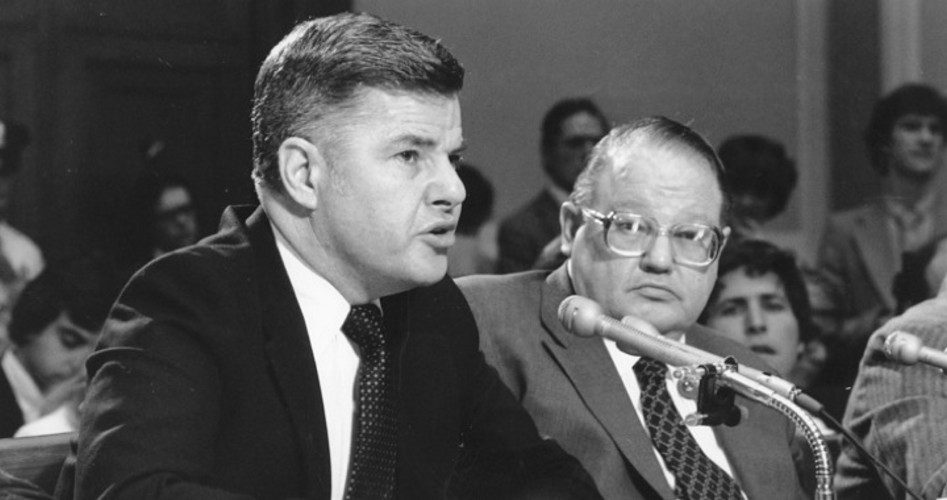
The following testimony given by W. Herbert Hunt was presented on May 2, 1980 before a House subcommittee probing the rise and fall of silver prices, amid allegations that the Hunt family had conspired to corner the silver market. As a result of the falling price of silver and other factors, however, the Hunts lost more than $1 billion in the silver market. (W. Herbert Hunt is shown testifying, with brother Nelson Bunker Hunt looking on.)
In early 1979, I became convinced that the economy of the United States was in a weakening condition. This reinforced my belief that investment in precious metals was wise and, because of the rampant inflation, that soft currencies were vulnerable.
I did invest substantially in silver futures contracts, but generally such purchases were completed before July 1979 when silver was selling for approximately $8.50 per ounce. Well after I established such positions, prices of silver on the two major exchanges, Comex and CBOT, rose to over $40 per ounce in 1980.
I’d like to point out that silver is by and large an expendable natural resource similar to coal, natural gas and petroleum. Both silver and energy have suffered from a government policy of interference in the free market.
Supply and demand has not been allowed to work. This has distorted prices and resulted in great price increases over relatively short periods of time.
For example, steam coal sold for $4 to $8 per ton in 1979 and now brings $25 to $30 per ton, for a 400 to 600 percent increase in price.
The average wellhead value of natural gas in 1973 was 21.6 cents per million cubic feet being controlled. Today, deep natural gas that is not subject to price regulation brings a free market price of $5 to, in some cases, over $6 per million cubic feet, or 25 to 30 times greater in price.
Petroleum was sold for $3 to $4 per barrel and now brings $30 to $40 in the world market, depending on quality, for a ten-fold increase in price.
Silver has enjoyed a similar price increase, rising from a price in 1973 of around $3 to $40 per ounce in 1980 before this last fall in price.
I have read in the media accusations about my silver investments, and I want to make it clear that at no time did I attempt to corner, squeeze or manipulate the silver market. At no time did I participate in an agreement to corner, squeeze or manipulate the silver market. At no time did I attempt or agree with others to attempt to manipulate the silver market.
Throughout the fall of 1979, the price of silver continued to rise despite the increasingly higher margin requirements imposed by the exchanges. In my view, it does not take a sophisticated market analyst to determine the effect of these higher margin and positive limit requirements.
First, access to the silver futures market by the average investor or speculator was denied by the high margin requirements. The result: There were no small buyers. Second, the position limits required large traders to dispose of their contracts. The natural result of these artificial factors was to drive the price of silver down. Mine was the distressful economic situation of being compelled to be a seller without buyers.
The exchanges finally broke the silver market on January 21 and 22, 1980. On the 21st, Comex limited trading to liquidation only. The decline in the price of silver continued until late March 1980. This rapid decline was the inevitable result of the actions taken by the exchanges.
The reason given by the exchanges for these abrupt changes in the rules and, in my opinion, manipulative actions was that there existed an emergency in the market; namely, that there was a lack of silver for delivery brought about by the presumption that those holding long futures positions would stand for delivery.
I submit that this was not the reason. The members of the board of directors, at least of Comex, are engaged, or represent firms engaged, in trading. Did some members of the board have a vested interest in forcing the market price of silver down?
The Wall Street Journal on Thursday, April 24, 1980 reported that there were members of the Comex board who did have a vested interest in seeing that the price of silver went down. These were representatives or employees of major precious metal dealers, or floor brokers who had acquired short positions as the price went up. I feel that this committee should ascertain whether conflicts of interest existed with respect to board members and their firms.
Were their actions between September 1979 and February 1980 market neutral; that is, did they not affect the price either up or down; or were they designed to drive the price of silver down? Did the board members profit from the market? Did the regulatory actions make this possible? Who had access to position reports, and was this information leaked to nonauthorized persons and firms in the market? It’s been reported that one investor reported gains of $100 million.
Have the board members engaged in market manipulation in concert or individually for themselves or their firms?
Photo at top shows W. Herbert (left), with Nelson Bunker Hunt, testifying on May 2, 1980: AP Images
Related article:



